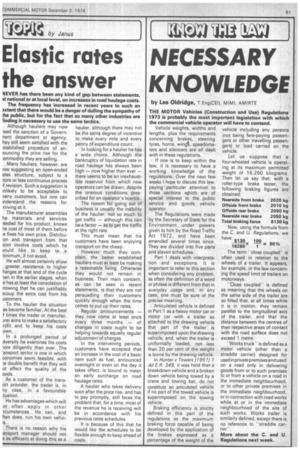Elastic rates the answer
Page 85

If you've noticed an error in this article please click here to report it so we can fix it.
VEVER has there been any kind of gap between statements, 3t national or at local level, on increases in road haulage costs.
The frequency has increased in recent years to such an axtent that there would be a danger of dulling the sympathy of the public, but for the fact that so many other industries are Finding it necessary to use the same tactics.
Although hauliers may now leed the sanction of a Governnent department or agency, hey still seem satisfied with the :stablished procedure of aniouncing the price rise for the ommodity they are selling.
Many hauliers, however, are low suggesting an open-ended ates structure, subject to a nore or less continuous process :f revision. Such a suggestion is rnlikely to be acceptable to nany customers, but one can :nderstand the reasons for rriving at it, The manufacturer assembles he materials and services leeded for his product, knows he cost of most of them before e fixes his own price. Distribuion and transport from that :oint involve costs which he iould like to keep to a ninimum, if not avoid.
He will almost certainly show greater resistance to higher harges at that end of the cycle an in the earlier stages, when e has at least the consolation of nowing that he can justifiably acoup the extra cost from his ustomers.
To the haulier the situation as become familiar. At the best f times the trader or manufacJrer aims to make a satisfactory rofit and to keep his costs own.
In a prolonged period of dversity he examines his costs lore diligently than ever. The :ansport sector is one in which 2onomies seem feasible, with le double benefit that they will ot affect the quality of the Dods.
As a customer of the transort provider, the trader is, in ny case, in a favourable tuation.
He has advantages which will ot often apply in other rcumstances. He can, and ften does, run his own vehic:s.
There is no reason why his ansport manager should not e as efficient at doing this as a haulier, although there may not be the same degree of incentive to make every mile and every penny of expenditure count.
In looking for a haulier he has a wide choice. Although the bankruptcy of liquidation rate in road haulage has always been high — now higher than ever — there seems to be an inexhaustible reservoir from which new operators can be drawn, despite the onerous conditions prescribed for an operator's licence.
The reason for going out of business is usually the inability of the haulier, not so much to get traffic — although this can be a factor — as to get the traffic at the right rate.
This must mean that his customers have been enjoying transport on the cheap.
However much they complain, the better established hauliers must at least be making a reasonable living. Otherwise they would not remain in business. Their main concern, as can be seen in recent statements, is that they are not persuading their customers quickly enough when the time comes to put up their rates.
Regular announcements — they now come at least once every three months — of changes in costs ought to be helping towards equally regular adjustment of charges.
In the intervening periods, customers have accepted that an increase in the cost of a basic item such as fuel, announced overnight or even on the day it takes effect, is bound to mean an early surcharge on road haulage rates.
A haulier who takes delivery soon after the price rise, and has to pay promptly, still faces the problem that, for a time, most of the revenue he is receiving will be in accordance with his previous rates schedules.
It is because of this that he would like the schedules to be flexible enough to keep ahead of costs.






























































































































